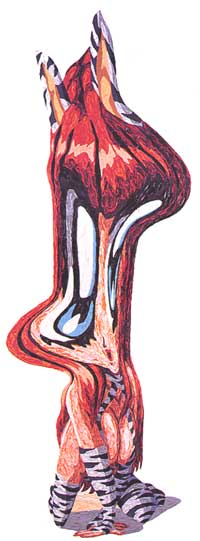by Darren Torres
_______________________________________
Japanese anime art, although considered somewhat new to "westernized"
culture, has a broad spectrum of styles adopted by American artists. Rather
than comparing Japanese anime art to contemporary American art, viewing
the evolution of styles within the same genre of expression, through different
artists, will show a relation between the artists and their works. Differences
in styles are represented through paintings and multi-media in the following
works of art. Styles expressed range from extremely abstract to "distorted"
and well-defined.
Supergod, although created by American-born Inka Essenhigh (1969-present), is a work of art that shows great influence from the Japanese culture. This highly abstract and enigmatic painting that hails from the Victoria Miro Gallery in London depicts humanoid formations in high-resolution color that would remind an on-looker of a still cel used in a "Japanimation" or Anime film. The apparent cyborg mutations, painted with oil and enamel on canvas, bring forth the subconscious question of a time frame not specified by the artist. For example, one could pose the question of whether the painting is taking place in the past, present, or future. Spectators are unsure of whether or not they are viewing man, animal, or machine as well. Subjective viewers are also unaware of seeing one object or many objects, as the artist made it a point to unify the work, but simultaneously separate different forms. Over all, the painting shows a very mythical, highly distorted depiction of an object or objects in unison, participating in an undefined activity.
In Mon Mon 2 (1997), James Esber (1961- present), another American-born artist with Japanese influence, uses similar distortion to depict his more well-defined subject. As opposed to creating a massive abstract, Esber makes more clear to the viewers what they may be witnessing. Using plasticine, otherwise known as modeling clay, on canvas, Mr. Esber pays his respects to a popular Japanese anime character and its existence. From the P.P.O.W. Gallery in New York, this rendition of the animation character is given a highly tempting, touchable depth, and obvious texture. Contrary to the smooth lines and defined proportions and colors of Japanese animation characters, this almost-sculpture-like work, possesses a trait that educated fanatics and uninformed passer-bys alike, will appreciate. Audiences realize the morphed contradiction of the character itself, while it seems to be forming into its more recognizable shape.
Born in the Netherlands, and again, influenced by Japanese culture, Micha Klein (1964- present) shows well-defined, tangible realism in Virtualistic Vibes, Space Nicky (1996). Displayed on high-gloss c-print and Perspex, and mounted on wood, this piece continues a visual tradition begun in 1927 with Fritz Lang's expressionist film entitled Metropolis. The futuristic-looking portrait itself shows a mercury-like, metal-substance-covered, human female form that is reminiscent of the one to first appear on screen in the aforementioned movie. Aside from being an emerging, experienced contemporary artist, Klein also works as a commercial designer and a club VJ. The model in the art originally appeared in a fashion layout for an underground Dutch magazine, in the traditional "perfect make-up, perfect-model pose". Also widely recognized, along with the history of the art itself, is the other influence that inspired the bright, flashing lights around the all- too-perfect beauty: the glossy, futuristic world of Europe's rave scene, which appeals to Eastern, European, and Western cultures alike.
Although
many styles are present in emerging anime-style art, these three transitional,
evolutionary styles stand out in this Westernized culture. Although none
of the artists mentioned are of actual Japanese decent, observers of their
art can see the impact that Japanese anime has had on the rest of the
world.

Mon Mon
2
by James Esber